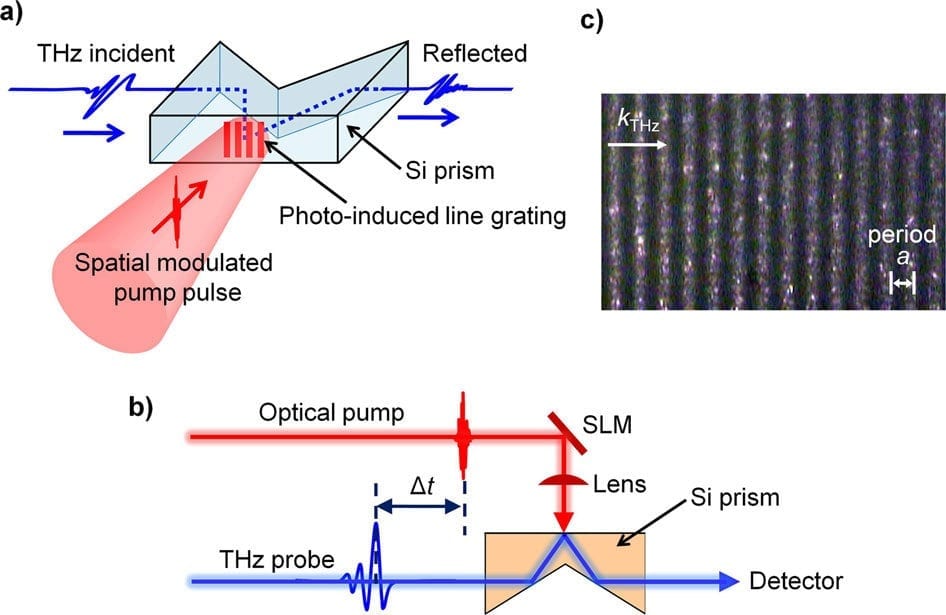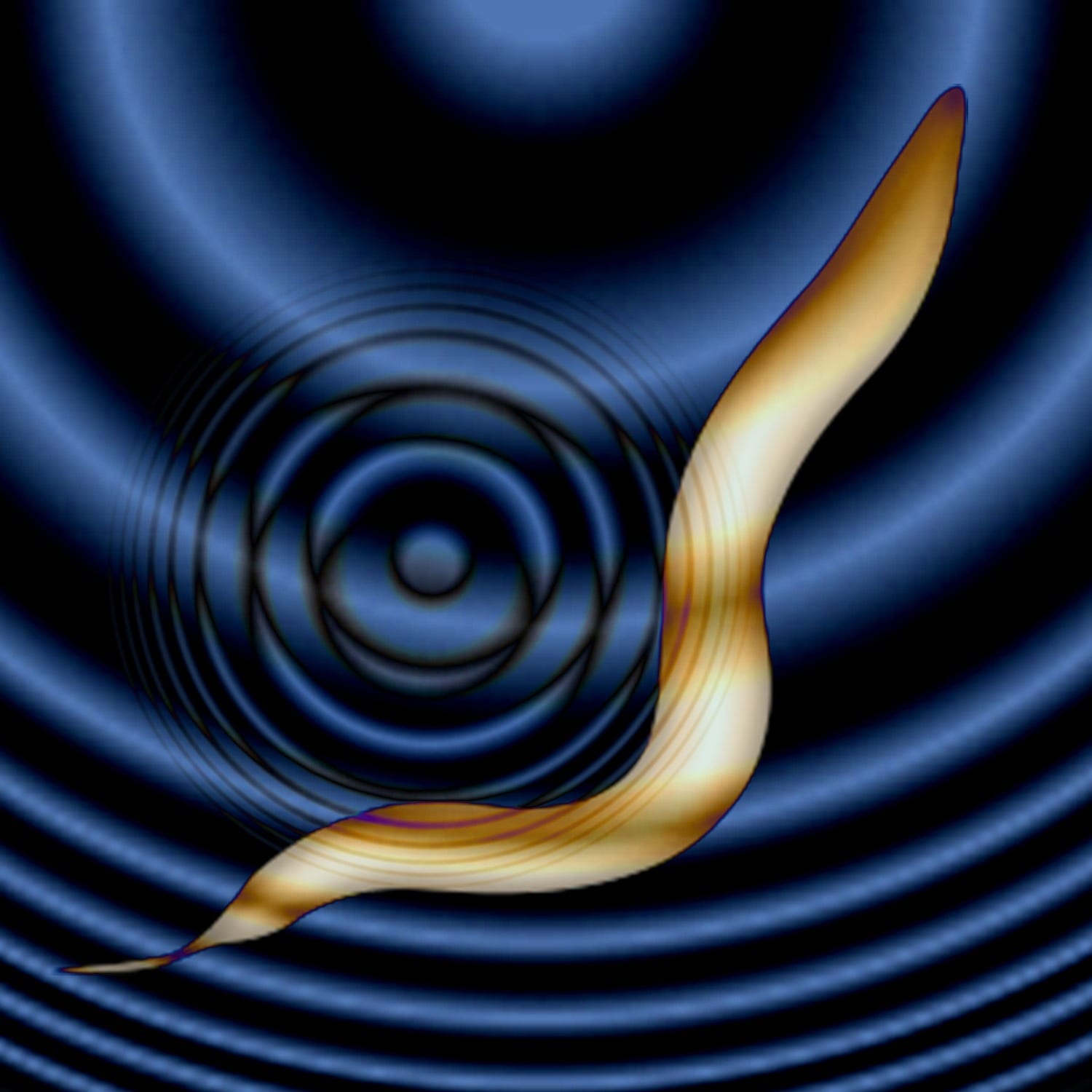
Terahertz waves leak out of a small slit in the antenna at different angles, depending on frequency. The receiver can be tuned to select one angle, plucking a single data channel from a stream containing many channels.
Mittleman lab/Brown University
Terahertz waves, operating at a much higher frequency than microwaves, could one day be used to carry data many times faster than today’s cellular and Wi-Fi networks. More work needs to be done before terahertz technology is deployed, but a Brown-led research team has made progress on one important part: multiplexing and de-multiplexing a terahertz stream.
Terahertz radiation could one day provide the backbone for wireless systems that can deliver data up to one hundred times faster than today’s cellular or Wi-Fi networks. But there remain many technical challenges to be solved before terahertz wireless is ready for prime time.
Researchers from Brown University have taken a major step toward addressing one of those challenges. They’ve developed what they believe to be the first system for multiplexing terahertz waves. Multiplexers are devices that enable separate streams of data to travel through a single medium. It’s the technology that makes it possible for a single cable to carry multiple TV channels or for a fiber optic line to carry thousands of phone calls at the same time.
“Any terahertz communications application is going to need some form of multiplexing and demultiplexing,” said Daniel Mittleman, professor of engineering at Brown and senior author of a paper describing the new device. “This is, to our knowledge, the first time anyone has demonstrated a viable strategy for multiplexing in the terahertz range.”
The research was published September 14 in Nature Photonics.
Today’s cellular and Wi-Fi networks rely on microwaves to carry voice conversations and data. But the increasing demands for data transfer are quickly becoming more than microwaves can handle. Terahertz waves have a much higher frequency and therefore more potential bandwidth. Scientists and engineers have only recently begun exploring the potential of terahertz waves, however. As a result, many of the components for a terahertz wireless network — including multiplexers — have not yet been developed.
The multiplexer that Mittleman and his colleagues have been working on makes use of what’s known as a leaky wave antenna. In this case, the antenna is made from two metal plates placed in parallel to form a waveguide. One of the plates has a small slit in it. As terahertz waves travel down the waveguide, some of the radiation leaks out of the slit. It turns out that terahertz waves leak out a different angles depending on their frequency.
“That means if you put in 10 different frequencies between the plates — each of them potentially carrying a unique data stream — they’ll come out at 10 different angles,” Mittleman said. “Now you’ve separated them and that’s demultiplexing.”
On the other end, a receiver could be tuned to accept radiation at a particular angle, thus receiving data from only one stream.
“We think it’s definitely a reasonable solution to meet the needs of a terahertz communication network,” said Nicholas Karl, a graduate student at Brown and the paper’s lead author. Karl led the experiments on the device with fellow graduate student Robert McKinney. Other authors on the study are Rajind Mendis, a research professor at Brown, and Yasuaki Monnai from Keio University in Tokyo.
One of the advantages to the approach, the researchers say, is that by adjusting the distance between the plates, it’s possible to adjust the spectrum bandwidth that can be allocated to each channel. That could be especially useful when such a device is deployed for use in a data network.
“For example, if one user suddenly needs a ton of bandwidth, you can take it from others on the network who don’t need as much just by changing the plate spacing at the right location,” Mittleman said.
The group plans to continue its work to refine the device. A research group from Osaka University is collaborating with Mittleman’s group to implement the device in a prototype terahertz network they’re building.
“This is a first-generation, proof-of-concept device,” Karl said. “There are still things we can do to improve it and we’ll continue to study it.”
Mittleman hopes that the work will challenge other researchers to start developing components for terahertz networks.
Read more: Researchers develop key component for terahertz wireless
The Latest on: Terahertz wireless
[google_news title=”” keyword=”terahertz wireless” num_posts=”10″ blurb_length=”0″ show_thumb=”left”]
via Google News
The Latest on: Terahertz wireless
- Deep learning empowers reconfigurable intelligent surfaces in terahertz communicationon May 9, 2024 at 10:38 am
The escalating demand for wireless data traffic, driven by the proliferation of internet-of-things devices and broadband multimedia applications, has intensified the search for innovative solutions in ...
- Japanese 6G prototype ‘can stream five HD movies a second’on May 8, 2024 at 8:28 am
Four Japanese firms have jointly developed a device capable of 100 Gbps transmissions in the 100 GHz and 300 GHz bands at up to 100 metres. Four Japanese telecoms firms have jointly developed what is ...
- Best Wireless Earbuds of 2024on May 8, 2024 at 4:00 am
Executive Editor David Carnoy has been a leading member of CNET's Reviews team since 2000. He covers the gamut of gadgets and is a notable reviewer of mobile accessories and portable audio ...
- Japan Releases 6G Device, 500% Faster Than 5Gon May 6, 2024 at 4:16 am
One of the earliest high-speed 6G wireless devices in the world was introduced by a consortium of Japanese corporations, including DOCOMO, NTT, NEC, and Fujitsu. Up to 330 feet (100 meters) may be ...
- Japanese companies develop 6G device capable of 100Gbps speedson May 3, 2024 at 9:35 pm
It was only in 2022 that 5G could arguably be considered to have gone mainstream. Two years later, scientists have already announced amazing results from a next-gen wireless technology—reaching speeds ...
- These 5 Best Wireless Dog Fences Keep Curious Pups Safe In Your Yardon May 3, 2024 at 9:59 am
Invisible dog fences don’t just help keep your pets safe and in sight while wandering your outdoor space: Compared with their traditional underground counterparts, the best wireless dog fences ...
- The Best Wi-Fi Routers for 2024on April 30, 2024 at 5:00 pm
Why We Picked It Wi-Fi 6E is the leading edge of consumer home wireless tech, so it's not a must-have for homes with many devices that might not yet support the standard. But being able to future ...
- The Best Wireless Keyboards To Go Cable-Freeon April 30, 2024 at 8:56 am
Picking the best wireless keyboard for your computer or phone isn’t just about which plastic slab can take years of your key hammering–it’s also about what kind of hammering you’re doing.
- Best wireless printers of 2024on April 25, 2024 at 8:35 am
The best wireless printers give you the ability to print from PC, laptop, and mobile devices without needing to plug anything in. Our team of reviewers tested out the top models to see which cable ...
- Reviews & Analysison April 23, 2024 at 5:00 pm
paving the way for high-data-rate and ultrafast terahertz wireless communications. Brillouin light scattering anisotropy microscopy affords single-shot collection of angle-resolved phonon ...
via Bing News










